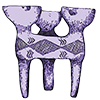Charlotte Gilman’ın Herland Romanında Mekansal Temsiller ve Cinsiyet arasındaki İlişkinin Analizi
DOI:
https://doi.org/10.33831/jws.v22i1.132Anahtar Kelimeler:
Cinsiyet ve mekan- mimarlık ve edebiyat- ütopyacı kurgu- Charlotte P. Gilman- HerlandÖzet
Bu makalenin amacı, edebi kurgu aracılığıyla mimarlık, iç mekanlar, kentsel çevre ve sosyal konular arasındaki bağlantıları araştırmaktır. Özellikle, toplumsal cinsiyet eşitsizliği ve hatta esas olarak cinsiyet ayrımcılığı gibi Charlotte P. Gilman'ın ütopyacı kurgusu Herland’i şekillendiren temalar üzerindeki etkilerini ve ipuçları ve yorumlar yoluyla mekansal temsiller analiz etmektir. Edebiyat içindeki mekan, hikaye anlatımının önemli bir parçası olarak görülebilir; çünkü okuyucunun yazarın literatür boyunca tam anlamıyla bütüncül olarak tasvir etmeyi umduğu çevreyi tam olarak kavramasını sağlar. Romanla ilgili olarak, tasvir edilen çevre, Gilman'ın ömrü boyunca maruz kaldığı cinsiyet eşitsizlikleri vurgular. Ayrıca cinsiyet Herland içindeki genel mekanı yönetir, bu nedenle mekan kadınlarla aynı özelliklere sahiptir; ülke sadece kullanıcı profilinden – Herland sakinlerinden faydalanmak amacıyla olduğu için vardır. Gilman, roman boyunca, tamamen farklı bir düzen ve işlev önererek zamanının mimarisini ve iç mekan normlarını eleştirir. Bahsedilen soruları ve sorunları ele almak mekan, cinsiyet ve edebiyat arasındaki ilişkiyi daha iyi anlamak için roman, yazar, yazarın yaşadığı dönem ve ilgili yayınlar derinlemesine incelenmiştir. Yapılan analiz, toplumsal cinsiyet rollerinin ortadan kaldırılması ve geleneksel alanların değiştirilmesi ile bu
İndir
Yayınlanmış
Nasıl Atıf Yapılır
Sayı
Bölüm
Lisans
Authors who publish with this journal agree to the following terms:
- Authors retain copyright and grant the journal right of first publication, with the work [6 months] after publication simultaneously licensed under a Creative Commons Attribution License that allows others to share the work with an acknowledgement of the work's authorship and initial publication in this journal.
- Authors are able to enter into separate, additional contractual arrangements for the non-exclusive distribution of the journal's published version of the work (e.g., post it to an institutional repository or publish it in a book), with an acknowledgement of its initial publication in this journal.
- Authors are permitted and encouraged to post their work online (e.g., in institutional repositories or on their website) prior to and during the submission process, as it can lead to productive exchanges, as well as earlier and greater citation of published work (See The Effect of Open Access)







